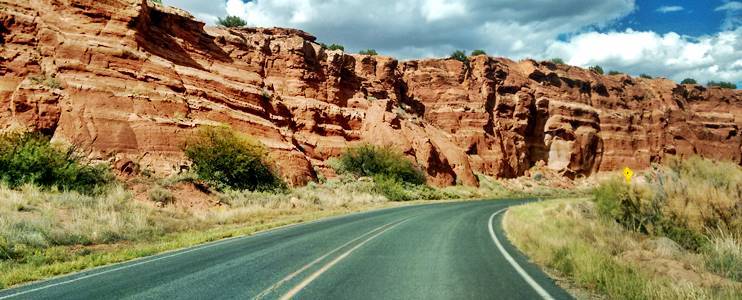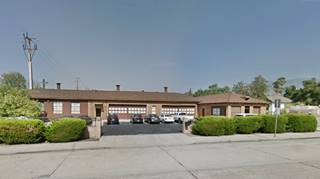About Monrovia California
Facts, Trivia and useful information
Elevation: 571 ft (174 m). Population 36,590 (2010).
Time zone: Pacific (MST): UTC minus 8 hours. Summer (DST) PDT (UTC-7).
Monrovia is a city located Route 66 in Los Angeles County in southern California on the San Gabriel Mountains' foothills; it is part of the Los Angeles metropolitan area. (Map of Monrovia).
A view of "Old Town Monrovia" along Mrytle Avenue:
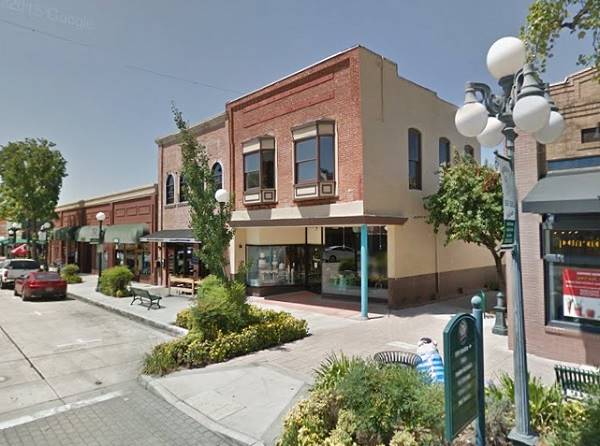
Click image for Street View
The history of Monrovia
The foothills of the San Gabriel Mountains have been inhabited during the last ten thousand years and when the Spanish reached the area in the 1600s, it was peopled by the native "Tongva". The Spanish named them after the mountains and the nearby mission (San Gabriel Arcangel) established in 1771: Gabrieleños or Gabrielinos. They were hunter - gatherers.
The Mission's land was nationalized by the Mexican government in the 1830s (Mexico had become independent from Spain in 1821), and granted the vast Ranch to local residents.
The land that would become Monrovia forms part of two Ranchos created in 1841 when Governor Juan Alvarado issued land grants to Andrés Duarte (the Rancho Azusa de Duarte - read more here) and Hugo Reid, a Scotsman naturalized Mexican (Rancho Santa Anita).
After Mexico lost all its territory north of the Rio Grande to the US during 1846-48 war, land grants were reviewed by the U.S. government, eventually Duarte's ranch was split and sold off to cancel debts and one of those subdivisions (240 acres) was bought by William Newton Monroe in 1883 for $30,000, and became Monroe Ranch.
The name: Monrovia
William Newton Monroe (1841-1935) was a school teacher, American Civil War Lieutenant and railroad engineer (for the Southern Pacific Railroad from Omaha to Los Angeles).
Monrovia is a Latinized form of his surname. The town's main street, Myrtle Ave. is named after is oldest daughter.
Several of Monroe's friends also bought land in the area and they founded a town, named after William Monroe in 1886, the land was sold by the Monrovia Land and Water Company.
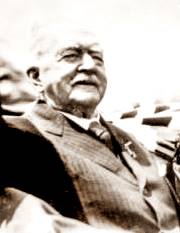
Mr. William Monroe
The Santa Fe railroad extended its line through Monrovia in 1887, linking its main line in San Bernardino across the San Gabriel Valley and into Los Angeles. That same year the town was incorporated and the High School was built. It was a liquor-free town.
In 1903 the Pacific Electric tram linked it to Los Angeles and it became a suburb of the great city.
The USGS geological survey along the Santa Fe railroad mentions Monrovia in 1915 : "Monrovia station is in the southern part of Monrovia, an old settlement lying against the foot of the mountains. West of Monrovia the railway swerves to the northwest for 2 miles and then goes west through the small towns of Arcadia, Santa Anita, and Lamanda Park into Pasadena".
National Old Trails Highway (N.O.T.) in Monrovia
The Automobile Club of Southern California (ACSC) 1912 map shows Duarte and Monrovia (20 mi.) and further west (after crossing the tracks twice), Pasadena. At that time, the use of cars had grown greatly and the National Old Trails (N.O.T.) Association was formed to promote a road between New York and Los Angeles; it passed through Monrovia along Foothill Blvd.
1926: Route 66 created
In 1926, US highway 66 (Route 66) was created and aligned along the N.O.T. highway through San Gabriel Valley. The 1935 Road map of Los Angeles show it going along this same route but the 1939 map has a different alignment, further south, along Huntington Drive. That same year, the "Guide to the Golden State" written by the WPA described the Monrovia section of Route 66 as follows:
"MONROVIA, 34.3 m. (560 alt., 10,090 pop.), was laid out in 1886 by W. N. Monroe, when lots today worth many thousands of dollars were sold for $100. Monrovia is surrounded by orange, lemon, and avocado groves and other orchards. Poultry raising and small gardening are important in the vicinity. The town is noted for a wide variety of trees and shrubs; in the northern part of town, is a papaya plantation."
In 1946, after World War II, Jack DeVere Rittenhouse drove along Route 66 collecting information for his "A Guide Book to Highway 66". In it, Monrovia is merely one among the many towns in San Gabriel Valley. He wrote: "More towns you pass through include... AZUSA, 343 mi., DUARTE, 347 mi.; MONROVIA, 350 mi., ....".
By the late 1950s, US 66 was being replaced by the L.A. freeway network and in 1964 it was officially bypassed in the San Gabriel Valley.
Where to Stay in Monrovia
Lodging in the City of Monrovia
> > Book your Hotel in town: Monrovia Hotels
More Lodging close to Monrovia along Route 66
Motels and Hotels close to Monrovia, California
Heading West... Hotels & Motels in California...
- 2 miles Arcadia
- 10 miles Pasadena
- 21 miles Los Angeles
- 25 miles Hollywood
- 37 miles Santa Monica
Heading East.... In California
- 6 miles Azusa
- 8 miles Glendora
- 11 miles San Dimas
- 17 miles Claremont
- 18 miles Pomona (South)
- 24 miles Rancho Cucamonga
- 33 miles Fontana
- 37 miles Rialto
- 42 miles San Bernardino
- 47 miles Cajon Junction
- 63 miles Hesperia
- 68 miles Victorville
- 81 miles Helendale
- 103 miles Barstow
- 257 miles Needles
Book your hotel in Monrovia
Booking.com>> Check out the RV campground near Monrovia, in Pomona
Weather in Monrovia

The climate in Monrovia is a Warm Summer Mediterranean climate. Rather dry and hot in summer but cool in winter (which is the rainy season). The average monthly temperatures does not exceed 71.6 °F (22°C).
Monrovia has some 290 sunny days each year and during fall (autumn) strong dry winds blow from the desert (Santa Ana winds) drying out the area and increasing the risk of wildfires in the foothills.
The summer average high is 89.4°F (31.9°C) and the average low is 61.1°F (16.2°C).
During winter the average high is (Jan) 67.8°F (19.9°C) and the average low is 44.3°F (6.8°C) in winter, the peaks of the San Gabriel Mountains receive snow, and may occasionally falls in Monrovia.
Rainfall averages 21.1 in. per year (536 mm), with the period May to October being the driest one with an average of 0.5 to 2.8 in. per month (12 - 71 mm). There are some 43.5 rainy days per year
Tornado risk
Monrovia is located very close to the Pacific Ocean and well beyond the Rocky Montains (which are the western limit for tornados) so there is no risk of tornados in the city.
Tornado Risk: read more about Tornado Risk along Route66.
Getting to Monrovia
You can reach Monrovia along old Route 66 or via Interstate 10, 15, 215, 610 or state higways 57 and 210. All of them are freeways.
Map of Route 66 through Monrovia
Static Map showing Route 66 alignment through Monrovia CA - CLICK ON MAP TO ENLARGE
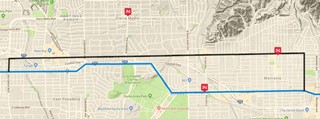
Click on Map to Enlarge
Color Key to the Map of Route 66 in Monrovia.
This is the map of Route 66 through Monrovia. The following color key applies to this map:
Pale Blue: the 1938 - 1964 Route 66 through Monrovia.
Black: the earlier, 1926 to 1938 Route 66 through Downtown Monrovia.
You can always check out our Route 66 Map of California, with the complete alignment and all the towns.
A Map showing Los Angeles
Route 66's alignment in California: the Historic Route 66 into Monrovia

Route 66 across California
U.S. Route 66 does not have any Byway or Historic designation in California despite the survival of long sections of original roadbed between Needles and Santa Monica.
Click Here for an overview of Route 66 across the state of California.
Below you will find detailed information on Old Route 66 in Monrovia.
Monrovia: Its Sights and Attractions
Enjoy Route 66!
Monrovia and its Route 66 attractions
The Gem of the Foothills
Monrovia has two Route 66 iconic lodgings: the Aztec Hotel and the Oak Park Motel, and various gas stations: the Flying A Service Station, the Monrovia Gas Station and an Antique Service Station. The Old Town Monrovia with its 1911 The Leven Oaks Hotel and the Monrovia's McDonald's with its antique logo or the 1920s Harding Court are other must see sights.
City tour
During its heyday, in 1947, the Monrovia-Arcadia area boasted 25 new motor lodges and motels and at the US Highway 66 Association convention in Oklahoma City, Walter Muller, the owner of the Westerner Hotel told his colleagues about the premium service offered by these motels, such as in-room phone service and "beautiful crystal swimming pools".
The classic motels in Monrovia have almost all been lost to development, malls and large parking areas next to Route 66: The Mon-Arc Motel (917 W. Huntington Dr.), the Monrovia Motor Lodge (715 E. Huntington Dr.), the New Salem Motor Court (741 E. Huntington Dr.), the Pacific Motel (721 W. Huntington Dr.) and the A-Wagon Wheel Lodge (926 S. 5th Ave.) have all gone. But, fortunately three antiques have survived: The Oak Park Motel, the Aztec Hotel and 'Leven Oaks Hotel are still there, though only one is still operating as a motel. Read about them below.
Begin your tour in eastern Monrovia on the city limit with Duarte, at the Oak Park Motel, just east of Route 66 and Mountain Ave. (Map with location).
Oak Park Motel
925 E Huntington Drive, Monrovia
This is one of the classics that have been on Route 66 since the 1950s. It is still operating under the same name.
You can Book a Room in the Oak Park Motel
The large oak seen in the postcard is no longer there, some palm trees give it a more Californian look. It should be noted that the expedition led by Portola in 1769 from San Diego through Los Angeles all the way to San Francisco and back, recorded the presence of large oaks in this region (in Spanish, "encino" = oaks), in fact a L.A. suburb is named "Encino".
Oak Park Motel in Monrovia
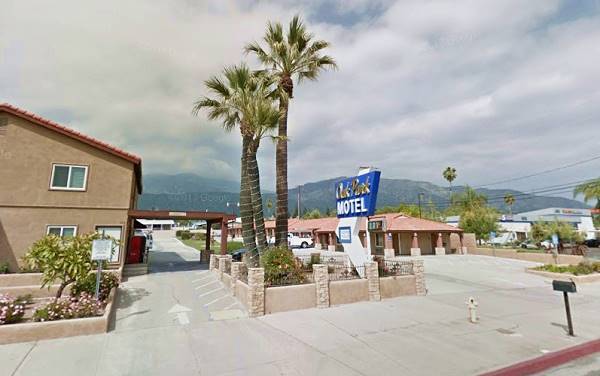
Click image for Street View
The cabins on the right side are part of the original building, but the one on the left is more recent as it does not appear in the postcard:
The Oak Park in a vintage postcard which describes it as "one of Los Angeles' newest and finest luxury motels"
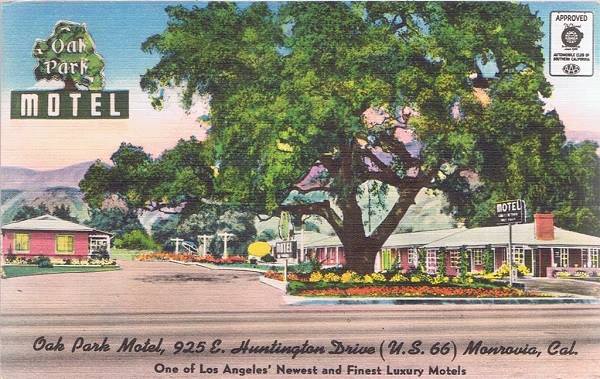
Head west along Huntignton Blvd. and when you reach Shamrock Ave. take a right and go 0.2 miles north, visit two classic service stations (See Map with directions).
Monrovia Gas Station
To you left, on the SW corner of Walnut.
Historic landmark
805 South Shamrock Avenue
Filed for Historic Landmark in Monrovia, it is an "L" shaped building that began as a fruit stand and home back in the early 1920s. The service station was added in 1926, just when Route 66 was created. In 1942 its gasoline filling island was demolished and the building became a small industry making military equipment during World War II, and in 1945 it was purchased by Halliburton.
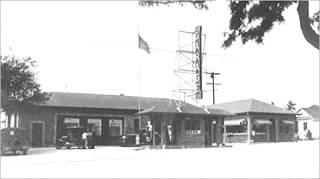
1920s photograph of the Historic Service Sation
City of Monrovia (Click for more information)
Across the street (Walnur St.) also to your left, is another classic Route 66 service station, the Flying A:
Flying A Service Station
S. Shamrock Ave. and Walnut, NW corner
It is one of two remaining antique Flying A Service Stations in Los Angeles County. Its service area faces the corner and has three vintage pumps under a canopy held up by two frontal columns. It was built in Mission Revival Style and has a stucco facade and the canopy is a roof with a hipped roof covered with Spanish tiles.
It dates back to the 1920s and was built here because this was the original 1926 alignment of Route 66 into Monrovia.
the Flying A Service Station in Monrovia
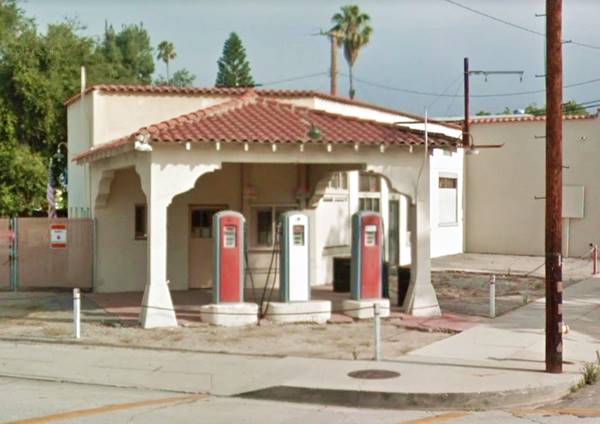
Click image for Street View
Keep north and at Foothill Blvd. turn left. Go west for 0.2 miles and to your right is an example of a 1920s "Bungalow Court":
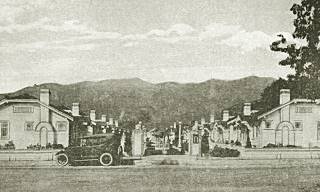
The Harding Court in the 1920s. patch.com
Harding Court
Historic landmark
401 E. Foothill Blvd.
A Landmark since it was designed and built by Sherman McQueen in 1920. The complex has fifteen three-bedroom bungalows that open onto a central garden. It was named after the then elected-President Warren Harding.
It was restored in 2002 and sold as private apartments.
Harding Court in Monrovia
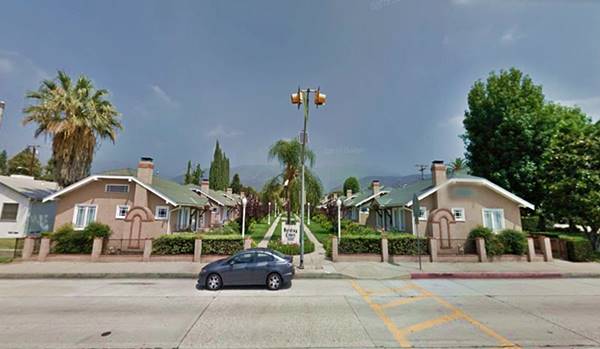
Click image for Street View
Continue west for 0.4 mi. (See Map), and take a left along South Myrtle Ave. (Myrtle was named after Monroe's oldest daughter) here is a hotel that is over 100 years old, the 'Leven Oaks:
The Leven Oaks
120 S Myrtle Ave.
The hotel was built in 1911 at a cost of $40,000, on South Myrtle and White Oak (present Foothill Blvd.) to provide decent lodging to visitors. It has a "U" shaped layout with a central plaza between the north and south wings. (See a vintage post card view of it).
the Leven Oaks in Monrovia
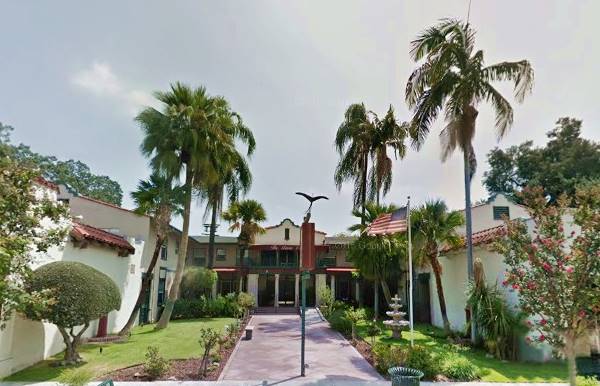
Click for Street View
It was named after eleven oaks that stood on the property, some of which were left untouched -and some of which survive to this day. It was designed by the Eagers in a Swiss style.
In 1984, its owner, Lisa Magno, turned it into an assisted living facility for seniors, and nowadays it houses 36 residents.
Continue south along South Myrtle Ave. to visit the Old Town Monrovia. Which begins there and is a 0.5 mi. drive - you can also park, and take a walk. (See map with directions).
Old Town Monrovia
Mark Twain Bench
Library Park, N.W. corner of S. Myrtle and W. Lime Ave (Map showing location).
Mark Twain is represented in a bronze statue reading his "Adventures of Tom Sawyer". The work was done by Gary Price in 2003.
Above there is a photo of the Old Town along Myrtle Ave.
See the Krikorian Monrovia Cinema (410 S Myrtle Ave.) and the brick facades of the old town's buildings.
The Bank of America on S. Myrtle and E. Palm St. was once a Van de Kamp's Holland Dutch Bakery with a windmill on its roof. The original old movie theatre-now converted to other uses- was in the block facing the Park.
This is the place to shop, sit down in a cafe or, between March and December, stroll through the weekly farmer's market on Friday nights. There is a "gateway arch" at the southern tip of the Old Town.
Head back to Foothill Blvd. and continue your westward journey for one block, to visit what used to be a service station to your right:
Former Service Station
127 W Foothill Blvd, Monrovia.
Now it is "Red's Drive Through" and you can still see the old streamline moderne style canopy over the concrete gasoline island, the small office and, to the left, the one-door repair shop.
former Gas Station in Monrovia
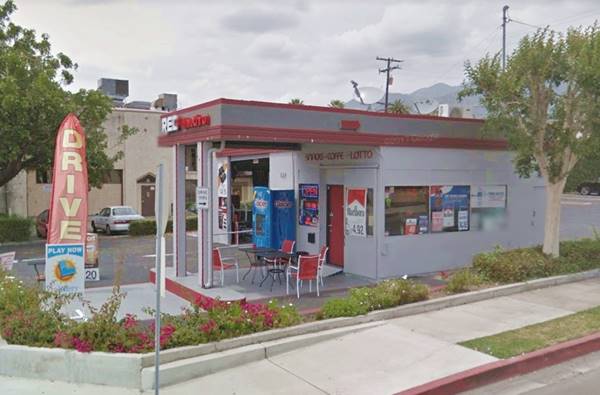
Click image for Street View
Three blocks west, On your right, on the NW corner or N. Magnolia and W. Foothill Blvd., See this vintage postcard of the Aztec Hotel.
Aztec Hotel
Listed on the National Register of Historic Places
311 West Foothill Blvd.
Aztec Hotel in Monrovia
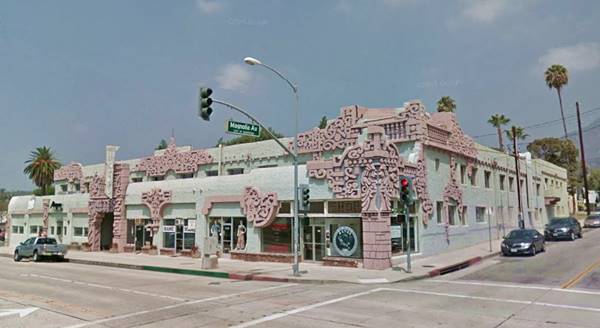
Click image for Street View
The 44-room Aztec Hotel opened in 1925 (one year before the creation of Route 66) and was built in "Mayan style" though it was named "Aztec" because its designer, architect Robert B. Stacy believed that the general public was more familiar with the Aztecs than the Mayans.
The reliefs and murals can be seen both outside and in the interior of the building. It prompted a short Mayan style boom which lasted a few years.
The 1930s realignment of Route 66 to Huntington Drive bypassed it. But it kept operating for many years. It was restored in 2000.
Back along Huntington Drive
Head south from the Aztec and visit a lovely Shell Service Station, built in Spanish Mission Revival Style (Map with directions, 1.2 mile drive). We are not sure if it is actually a 1940s place. Perhaps some reader can let us know for sure. See its street view.
The later alignment of Route 66
Take a left eastbound, along Route 66, which is the post-1935 alignment of the Mother Road through Monrovia.
Just 0.3 miles east, to your right is the Mc Donald's:
McDonald's in Monrovia
480 W Huntington Dr.
Patrick McDonald opened his first food stand near the old Monrovia Airport, on Huntington Drive back in 1937. He named it after the appropriately "The Airdome". Patrick and his two sons (Richard and Maurice) moved their business in 1940 to San Bernardino where it became the First McDonald's Burger Restaurant.
In 1952 the two brothers decided to give their buildings a striking design and hired Stanley Clark Meston who included two stylized yellow parabolic arches, one on each side of the building. The "golden arches" had been born.
They were used in the new restaurants opened between May 1953 and the 1960s, when the arches were eliminated from buildings. In 1962 the new logo was created which had the yellow "M" resembling a McDonald's store viewed from an angle (the two golden arches) and a red isosceles trapezoid "roof" as background for letters. The arches cross over each other at the bottom. This was removed in later logos where they meet in a single point.
As you can see below, this McDonald's has the "old logo" which was stylized into the "Striked M" seen in this restaurant, where a yellow line strikes across the "M" as in the original logo (the slanted roof). Notice the column with an "art Moderne style" too.
Mc Donald's in Monrovia
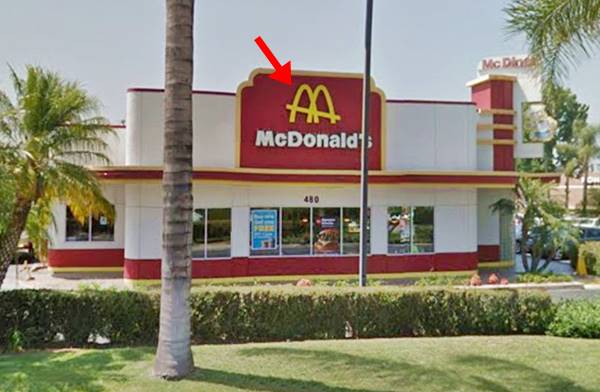
Click image for Street View
More memorable McDonald's in Southern California
Read about the other three memorable McDonald's on Route 66 in this part of California: the First ever McDonald's in San Bernardino (now a museum) and the Upland Golden Arches and the other Golden Arches in La Verne.
Tours & Itineraries
Old Route 66 in Monrovia California
From Duarte through Monrovia
The first highway through the area built specially for cars, was the National Old Trails highway projected in the early 1910s to link Los Angeles and New York.
Route 66 in Monrovia: two alignments
There were two alignments through the town, the original one, followed by the N.O.T., and incorporated into Route 66 when it was created in 1926, and the newer one which replaced it in 1938, a shorter alignment, with less 90° curves that bypassed the town on its south side (in those days, because today it is in the midst of Monrovia):
Old Alignment from 1926 to 1938
This is shown in Black in the Map above. Driving east to west, coming from Duarte, the old route 66 took a sharp right curve heading north along Shamrock Ave. and then, a left along E. Foothill Blvd.
The road then headed west all the way across Arcadia, Sierra Madre and took a left to the south, on San Gabriel Blvd. up to E Colorado Blvd. at this point old and new alignments meet and head straight along it westbound, into Pasadena. See the Map of the 1926-38 Route 66 in Monrovia.
New alignment from 1938 to 1964
This is shown in Pale Blue in the Map above. At that time, Foothill Blvd. was improved eastwards all the way to San Bernardino, work that began in 1931. So the alignment of US 66 was widened and straightened out, to make it safer. This led to the bypassing of the roundabout road across the downtown area of Monrovia via Foothill Blvd.
Route 66 kept westbound straight along Huntington Drive across Monrovia and into Arcadia, where it curved around the racetrack and became E. Colorado Blvd. continuing along it all the way to Pasadena. See the Map of the 1938-64 Route 66 in Monrovia.
The course of Route 66 between Duarte and Monrovia is a simple segment, because both towns are contiguous and you will not notice where one ends and the other one begins.
In Monrovia, Route 66 extends for 2.8 mi along Huntington Dr. between a point just east of Mountain Ave. in the east and 5th S. Ave. in the west, see this Map.
> > See the previous segment Victorville to San Bernardino
> > See this segment San Bernardino to Pasadena (west)
Accommodation Search box:
Sources
A Guide to the Golden State, by the Federal Writers' Project of the Works Progress Administration, Hastings House, New York, 1939.
Banner image: Dead Man's Curve, Laguna New Mexico by Perla Eichenblat.

